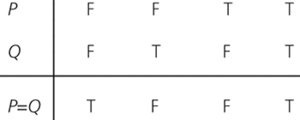1. The logical connective combining two statements or formulas P and Q in such a way that the outcome is true if both P and Q are true or if both are false, as shown in the table. P and Q are said to be equivalent. The connective can be read as ‘if and only if’ or ‘iff’, and is usually denoted by one of the following symbols:
See also exclusive-NOR gate, propositional calculus.2. A relationship between objects that are operationally or structurally indistinguishable, e.g. in combinational circuits, graphs, or grammars. Equivalence is less strong than identity or equality but much more useful in practice. See also machine equivalence

Equivalence. Truth table
.
A problem of non-uniqueness in the interpretation of electrical soundings, when identical trough- or peak-shaped apparent resistivity graphs for a three-layer case can be synthesized using different models for the middle layer. Identical peak-shaped graphs can be generated if the transverse resistance, Rt, remains a constant equal to hρ, where h is the thickness of the layer and ρ its true resistivity. Identical trough-shaped graphs can be generated if the longitudinal conductance, Gx, remains a constant equal to h/ρ. Such problems can be resolved if access is available to borehole geologic control and the range of h or ρ can be deduced.
- international division of labour
- international economics
- International Electrotechnical Commission
- International Federation of Digital Seismic Networks
- International Finance Corporation
- international financial system
- International Fund for Agricultural Development
- International Gamma-Ray Astrophysics Laboratory
- International Geomagnetic Reference Field
- International Geophysical Year
- International Geosphere–Biosphere Programme
- International Gravity Formula
- International Gravity Standardization Network
- International HapMap Project
- International Institute of Space Law
- International Labour Organization
- International Liquid Mirror Telescope
- International LOFAR Telescope
- International Magnetospheric Study
- International Microgravity Laboratory
- International Mineralogical Association
- International Monetary Fund
- international monetary system
- International Monitoring Platform
- International Nucleotide Sequence Database Collaboration